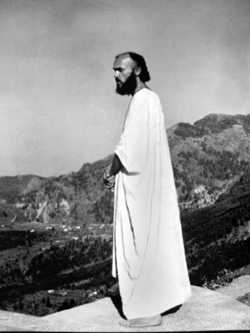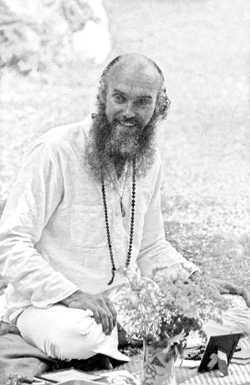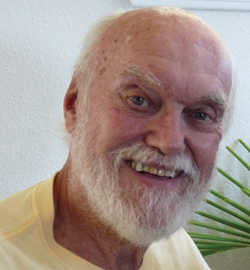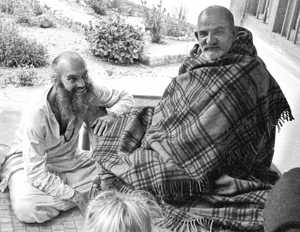 Be Here, Be Love, Be Now with Ram Dass
Be Here, Be Love, Be Now with Ram Dass
To even attempt to put words to the impact Ram Dass’ grace and presence has had over the past forty-plus years would be a task, indeed. In 1967, one young Dr. Richard Alpert, former Harvard psychologist, made a foray to India in 1967, where he met the iconic blanket-clad Hanuman devotee, Neem Karoli Baba, who named him Ram Dass, servant of Ram. Numerous books (including the classic Be Here Now, celebrating forty years of inspiring seekers), the founding of the Hanuman Foundation in Taos, which initiated the Prison Ashram Project (now run by Sita and Bo Lozoff), co-founding the Seva Foundation and the creation of the Dying Project, are only a few of his multitude of influential endeavors.
Probably the most impactful teaching Ram Dass offers is his presence itself. He is an iconic guide, role-model and teacher, who is always ready with a bright smile, an easy laugh and a curious exploration into the heart of the spiritual journey. We had the opportunity to share some grace and some laughter with this much-beloved connector of ideas across time and tradition.
Interview with Ram Dass
Felicia M. Tomasko: What do you see as the greatest gift that you have received from your teacher?
 Ram Dass: From my teacher, my guru, I learned to surrender to God in my life. He showed me how much I can live in my Atman, the real self. The gift was him and he is with me most of the time during my life. He gives me a perspective on my life and of the events in my life – that this is only one life. I see my life is so enriched. He’s given me faith. His grace gives me the experience that my life is full of grace.
Ram Dass: From my teacher, my guru, I learned to surrender to God in my life. He showed me how much I can live in my Atman, the real self. The gift was him and he is with me most of the time during my life. He gives me a perspective on my life and of the events in my life – that this is only one life. I see my life is so enriched. He’s given me faith. His grace gives me the experience that my life is full of grace.
FMT: How would you describe that grace in your life?
Ram Dass: Every moment is spiritual. You look out at the trees and the sky and know it’s from God. I think that is what grace gives to me.
FMT: Having that ongoing spiritual experience sounds like a great gift. Is there anything you have to do to perpetuate that or be able to stay in that space? Do you ever forget and what helps you to remember?
RD: I always forget! I have mechanisms and spiritual practices that make me remember. I can just say that I have forgotten, and when I forget I usually ask, “What am I doing at this place?” Then I know to quickly do my practices.
FMT: As people are starting out on their own spiritual path, how would you recommend they find their own mechanisms to remember or find their own way to connect with that grace?
RD: They would have to be identified with their real self and be free of identification of the ego. That means that they have to go from here [Ram Dass gestures to his head] to here [Ram Dass gestures to his heart].
The way I do it is this: I think, “I am loving awareness.”
If they focus on the middle of their heart space and repeat, “I am loving awareness, I am loving awareness, I am loving; I am loving,” they’ll then repeat it from that place where they will be a witness to their melodrama.
That brings them closer to other people because they see their souls. It brings them closer to their guru. They may not have a guru on this plane, but everyone has a guru.
I sat in the bus debating, “Ice cream or holy place; ice cream or holy place?” and I went through a very tough time trying to make a decision. I said, “We’re all here in India for spiritual things, we should visit a holy place.”
FMT: That’s a strong statement.
 RD: For example, my guru left his body in 1973, but I don’t notice any difference. Everybody has a guru that they can call on. They can call their guru by any name: an angel, or Jesus or Hanuman, Krishna; there are plenty of names.
RD: For example, my guru left his body in 1973, but I don’t notice any difference. Everybody has a guru that they can call on. They can call their guru by any name: an angel, or Jesus or Hanuman, Krishna; there are plenty of names.
FMT: I know many people who call Neem Karoli Baba their guru even though they have never met him physically.
RD: I give everybody my guru [Neem Karoli Baba]. He said, “All a person has to do is to think of me and I’m there for them.” Anybody who says, “I haven’t a guru,” he is there for them.
FMT: He has been one of your great gifts to so many people. You have given this gift in sharing what you have learned from him. Did you have any idea when you wrote Be Here Now the impact that it would have decades later?
RD: I didn’t have any idea, but before I left India the first time in 1969 (something like that), he [Neem Karoli Baba] gave me his aasheervaad for my book. I said, “What is aasheervaad and I’m not writing a book.” He said, “Asheervaad is blessings and I don’t know what the book is or what it’s going to be.”
I went back to New York and gave some lectures. A woman in the audience was a stenographer and she copied the words down and gave me this sheet of paper saying, “Here are your words.” Then I carried it in the trunk of my car to California and the guy that took my bags asked, “What’s that?” I told him that this woman made it for me he asked, “Well, can I look at it?” When he looked at it he said, “Those are some really good stories.”
I put it back in the trunk. For my next stop, I was in New Mexico at a wonderful commune that I helped form [The Lama Foundation]. Steve Durkee began to take my bags down and asked, “What’s that?”
We sat around the dinner table reading the stories. He is a great artist and he and other artists were saying, “I can do that,” “I can do this.” It wasn’t my book anyway. It’s his [Neem Karoli Baba’s] aasheervaad. All their creative talents came to me. In the first version of the book, all the components were in a box including a record with kirtan, pictures of saints that you would stick up in the refrigerator and little quotes from spiritual masters you could put on your mirror in the bathroom. Then we decided to make a book, this is what turned out to be Be Here Now.
FMT: What has been the most surprising response to the book?
RD: So many people have started their spiritual path with that book. Now I think that it’s been two million copies that have gotten out. That is surprising. New people – like kids who are in their teens are holding the book and they value the spiritual things that are in the book. That’s pretty good! [Ram Dass beams.] My guru sat on his tucket and he said one blessing and two million people got a push onto spirit – so that’s pretty good.
FMT: I’d have to agree what a great blessing that he imparted. The work that you do now isn’t just with your writing, although you do have the book, Be Love Now. You are also still teaching on a regular basis in Hawaii. What is it that you teach…
RD: That’s not all; I’m on the board of the Hanuman Temple in Taos and I teach a class on dying in San Francisco, via Skpe. But now I don’t leave Maui; I’m an island boy. I’ve had it with flying miles in planes. Now I am here content. I never had contentment in my life and now I am content. I think it’s connected with aging. I sent an article to the AARP magazine on contentment and they didn’t buy it. It is contentment; but it’s spiritual contentment. It’s so rich and so yum yum yum.
FMT: In the dying class that you’re teaching, do you think that your stroke helped you come closer to that process?
RD: I gained compassion.
Before the stroke, Paul Gorman and I wrote a book called How Can I Help? It was full of what came from helping; now I think I would write a book on “How can you help me?” because I think that I am now learning about dependency and it’s not an easy lesson in our culture.
Before the stroke I was teaching classes called conscious aging and also I was teaching classes on dying. All I do is to teach people to sit on the bedside of a dying person and let them die in their own way. The person at the bedside should be a loving rock – a rock that the dying person can push against. To train people to be by the bedside, we get them to get to identify with their own souls, and then they will be ready for death. I helped my parents die and helped my stepmother die; I helped so many friends die. My father was a power-oriented man who operated from his ego, but when he was ninety-five years old and I helped him diet, he turned into a beautiful soul.
FMT: It sounds like it comes back to what you were talking about at the beginning of this conversation about feeling grace and God in every moment, feeling the spiritual nature of life.
RD: I realize now that I identify with my soul and I see the souls of so many people even though they don’t see their own souls. You can go into the grocery store and there are people in there who are customers and there are people who are clerks, but they are identifying with their roles, not their souls.
FMT: Identifying with their roles, not their souls. That’s a good one; I bet you’ve used that before.
RD: Yes!
FMT: We do often identify with our roles and sometimes it’s so challenging to identify with the soul – or it can feel confusing.
RD: It is very confusing! Spiritual life is very confusing.
FMT: But once you get started on the path of the spiritual life, there is no real going back.
RD: Absolutely! That is true.
FMT: With the confusion, there also comes grace – if we allow it. You brought up a key word earlier when you mentioned surrender. Do you feel that surrender is what helps us to break through the confusion?
RD: In the East, surrender is the way, but in the West surrender is a terrible word. I say that I surrender to the God that is within my soul: the Atman. I don’t surrender to another man but I surrender to God.
I have a story about surrender. The first time I was in India, I was told that I’d come back to India in two years. I came back and I couldn’t find my guru. That was very unfortunate because he said to come back in two years and then I couldn’t find him, so I decided to go a Vipassana meditation course; there were fifty people in this course in Bodh Gaya.
I was having a terrible time because as much as I wanted to be meditation, I kept thinking, “Where is my guru?” so I decided about halfway through the course that I would leave and go looking for my guru.
During tea time, I was telling the girl next to me that I was going to leave and she said, “Well I’d love to go and meet your guru. I have a friend who has a huge bus that he brought from England to India and maybe he would like to join us. We could take the bus to go looking for your guru.”
Twenty-four of us left the course in the bus and I was the leader of the posse. We were planning to take go directly to Delhi, for ice cream and soft beds after the meditation course. The owner of the bus asked if we wanted to go straight to Delhi, or off to the right to the holy city of Allahabad, the location where the Kumbh Mela is held, where all the saints come together. We did go to India to visit holy places, so I thought, “Yeah, that would be a very holy place.”
I sat in the bus debating, “Ice cream or holy place; ice cream or holy place?” and I went through a very tough time trying to make a decision. Finally the bus driver had to ask me, “Do we go straight or take a right?” And I said, “All right, go right. We’re all here in India for spiritual things we should visit a holy place.”
As we were coming to a huge field where the Kumbh Mela had been, there were maybe just a few walkers and dogs and someone in the back of the bus said, “There is Maharaj-ji [Neem Karoli Baba]!”
Maharaj-ji and his fellow devotee were walking by the bus going the other way so I said, “Let’s get out and touch his feet.”
We all got out and surrounded him and he said, “Come on, follow us.” They had a rickshaw so this little rickshaw and a big bus began traveling together. He didn’t say where he was going.
That was at about eleven in the morning and I had made my decision to turn right at 10 A.M.
Finally we arrive at a house and a woman comes out, the wife of the man who was walking with Maharaj-ji. She says, “Oh, we were waiting for you. At six in the morning, a phone call from Maharaj-ji woke us all up. He said, “I want you to have a table of food ready for lunch for twenty-five people.” Twenty-five people included the bus driver! At six am, they knew we were going to come there for lunch while I was still deciding. After that, I don’t decide much anymore.
My guru sat on his tucket and he said one blessing and two million people got a push onto spirit – so that’s pretty good.
FMT: What a powerful example of surrender. As you said, surrender can be misunderstood. To be able to be in that space of grace is powerful and I think your books and teachings give people an example of what it means to live that grace. Neem Karoli Baba was also an example of that grace.
RD: At least we think that.
FMT: Thank you for sharing.
RD: This is soul to soul. You laughed at all the right times and the feeling of your heart is in this and that’s rewarding for my heart.
It is rewarding for my heart to get to share this.
For more information about Ram Dass’ work and teachings, visit: ramdass.org
Felicia Tomasko has spent more of her life practicing Yoga and Ayurveda than not. She first became introduced to the teachings through the writings of the Transcendentalists, through meditation, and using asana to cross-train for her practice of cross-country running. Between beginning her commitment to Yoga and Ayurveda and today, she earned degrees in environmental biology and anthropology and nursing, and certifications in the practice and teaching of yoga, yoga therapy, and Ayurveda while working in fields including cognitive neuroscience and plant biochemistry. Her commitment to writing is at least as long as her commitment to yoga. Working on everything related to the written word from newspapers to magazines to websites to books, Felicia has been writing and editing professionally since college. In order to feel like a teenager again, Felicia has pulled out her running shoes for regular interval sessions throughout Southern California. Since the very first issue of LA YOGA, Felicia has been part of the team and the growth and development of the Bliss Network.


